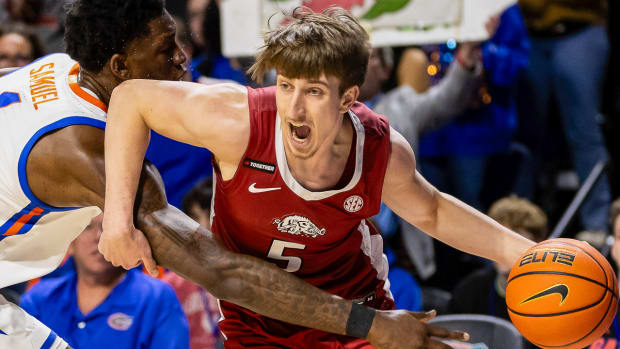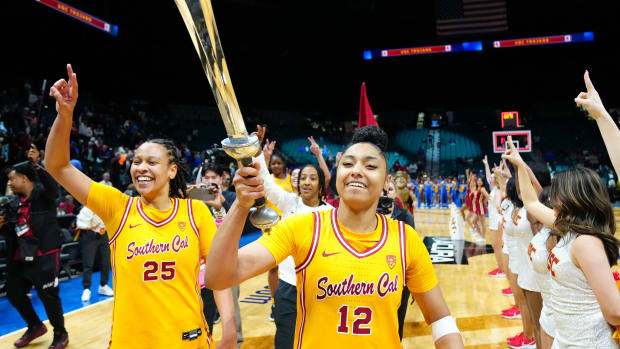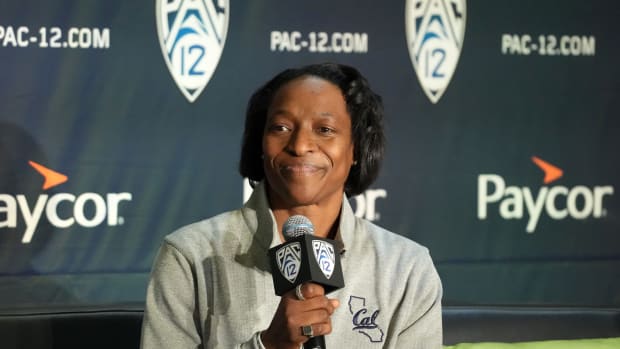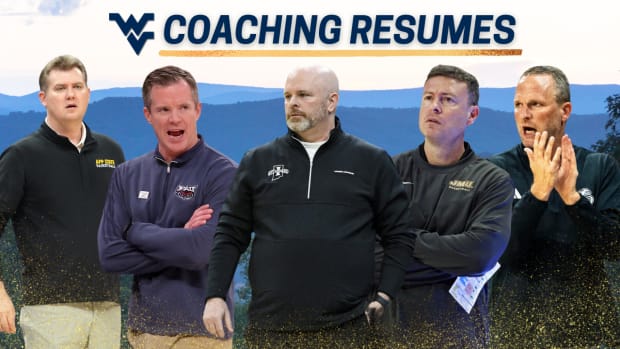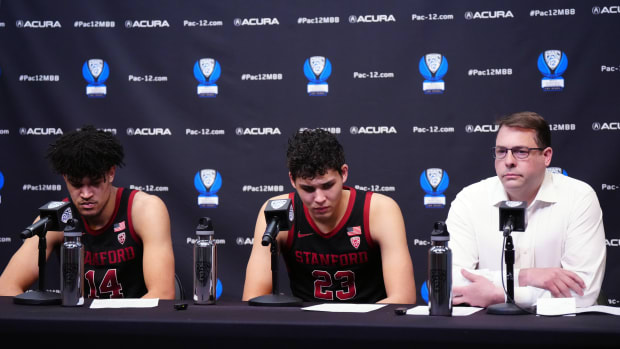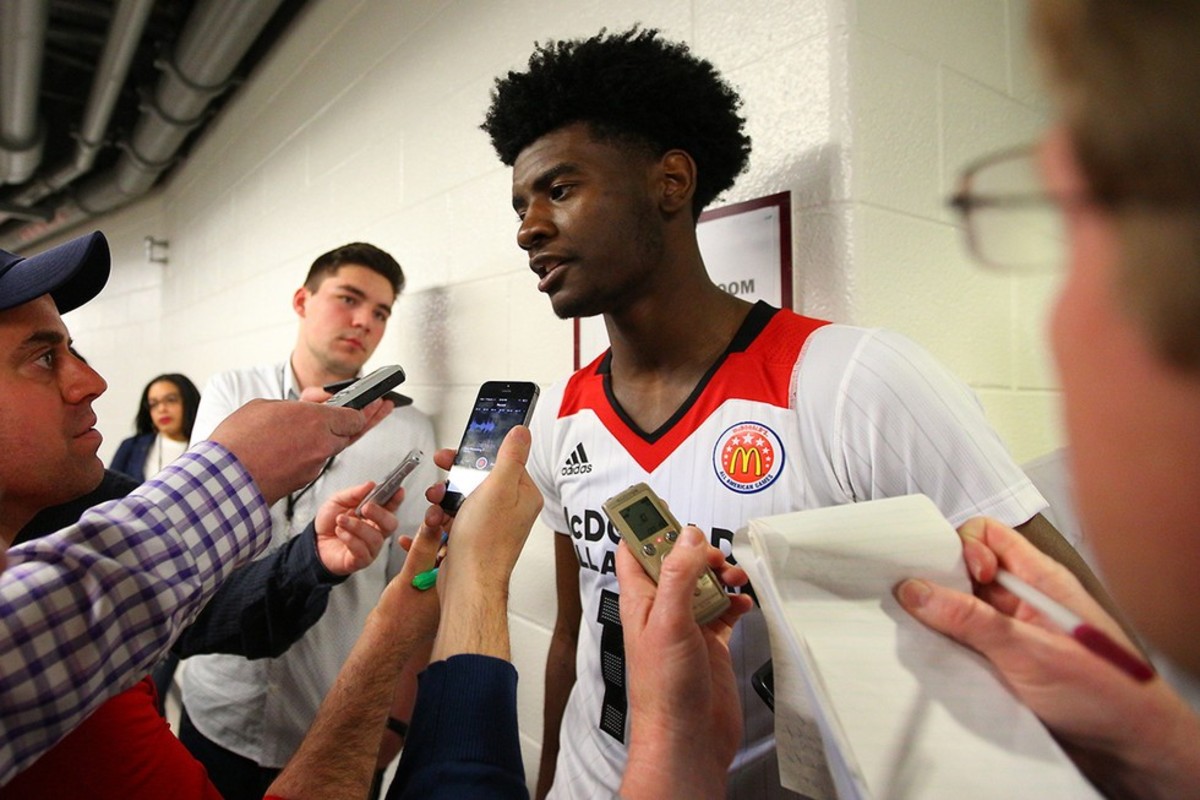
Why top college basketball prospects are forgoing traditional high schools to join superteams
This story originally appeared in the June 27, 2016, issue of Sports Illustrated. Subscribe to the magazine here.
On a warm January night a crowd gathers at a community college in northern California wine country, in a building flanked by a golf course and a vineyard, hoping to glimpse the future of basketball. The talent on the floor is undeniable. As 6' 7" Josh Jackson slashes to the basket, fans see why his trainer calls him "the next Kobe Bryant"—and why some independent experts agree. Jackson, who has signed with Kansas, is the likely No. 1 pick in the 2017 NBA draft.
On the opposing team, 7-foot DeAndre Ayton flashes the size, footwork in the post and outside shooting touch that have drawn comparisons with Tim Duncan and make Ayton the front-runner to be the No. 1 choice in the 2018 draft.
A generation ago Jackson and Ayton would have been playing for public high schools in their neighborhoods, or elite private schools nearby. Instead, they play for programs that aren't really schools, in towns that are a long way from home.
Jackson, a native of Detroit, plays for Prolific Prep in Napa, Calif. If you live in that area and have never met a Prolific Prep alum, there is a reason: It was formed in 2014 by Jeremy Russotti, a top basketball skills trainer who is based in northern California, at the suggestion of Jackson's mother, Apples Jones. Russotti has built a national power around Jackson, but he has not built an actual school. Prolific Prep has no physical address. Russotti jokes that the school is "a P.O. box and three cellphones." It exists purely as a basketball superpower. Jackson and his 12 teammates attend classes at Justin Siena, a Catholic school in Napa that costs nearly $19,000 per year. (Jackson received a scholarship through Prolific.)
Ayton's path to that Napa gym was even stranger. After coming to the U.S. from the Bahamas at age 12, he began his career at Balboa City School in San Diego, an established private school that did not have any athletic programs until it formed a basketball team around Ayton. That shotgun marriage did not last, and now he attends Hillcrest Prep, a Phoenix school that outsources its academics. But Hillcrest's academic credentials are in question, and several top colleges have backed away from recruiting Ayton. "Right now, it's Kansas. That's it," he told the Louisville Courier-Journal in April. "I'm only seeing Kansas right now. I don't know [why]. The word is I'm not going to college or something, but I say college is a must."
In the last decade much has been written about diploma mills: schools that teach nothing, yet graduate their students, many of whom just happen to be elite athletes. Every time one of these schools disappears, another one seems to pop up—NCAA officials describe monitoring them as a game of whack-a-mole. They are struggling to understand why elite athletes with so many options keep choosing schools that could jeopardize their eligibility. In the class of 2017 alone, three of the top 15 players are attending high schools that did not exist five years ago.
But not every pop-up school is a diploma mill—some offer legitimate educational programs, including online classes—and the larger phenomenon is complicated. It's a product of years of changes in the basketball landscape: the increased influence of sneaker money, a paradigm shift of high school basketball programs resembling AAU teams and a transfer culture at every level of basketball.
Josh Jackson and DeAndre Ayton did not start this trend. As they performed in Napa, in front of a crowd that included NBA agent Aaron Goodwin, adidas executive Chris Rivers and Washington coach Lorenzo Romar, it was natural to wonder: Are these supreme talents working the system in their favor? Or is the system taking advantage of them?
*****
Al Tielemans
Two years ago Josh Jackson led Consortium College Preparatory High in Detroit to the Class C championship as a sophomore. For most of the last century such an achievement would have been the pinnacle of a high school player's career. But for this generation, basketball names are made in the summer, not the winter—and by the time Jackson won the state title, he had already made his.
Seven months earlier, at the prestigious adidas Nations event in Long Beach, Calif., he had played veteran NBA shooting guard Arron Afflalo to a draw. Jackson showcased the energy, athleticism and versatility that make scouts gush. He had finished just his freshman year of high school, but draft websites began buzzing about him as a potential top five draft pick in 2017.
In the stands in Long Beach, Jones watched the clusters of people around her son grow after each game. Strangers introduced themselves, asked for his phone number and handed him business cards. Some were sneaker company representatives; others were financial planners or runners for agents. Jones eyed them all warily.
"I just stepped in, like, Wait a minute, why are you talking to him?" she says. "You're grown. You should be talking to a parent, you know? That's when it kind of woke me up. . . . They're trying to get this kid, and they're saying whoever gets the kids get a contract [for themselves] or whatever."
Three years later Jones, 43, is standing outside the restaurant of her choice in Napa: Denny's. She crushes out her cigarette and swaggers in for her grits and heavily peppered scrambled eggs, wearing jeans emblazoned with NBA logos. (She points out that the jeans are so old—11 years—that the Nets logo is still from New Jersey.) Jones is not slick like the men with business cards. But she has Jackson, and that gives her power and confidence. After the showcase in Long Beach, she was determined to take control.
"My job as a parent is to keep my son protected," Jones says. "It's a full-time job."
Jones started managing her son's career long before he officially had one. She scheduled recruiting visits and kept agents and runners at arm's length. She monitored which coaches and media he spoke with. With abnormal amounts of attention coming unusually early, she did her best to make his life as normal as possible.
Jones spoke with the three major shoe companies (Nike, adidas and Under Armour) about starting a grassroots athletic travel program based in Michigan. In January 2014 she signed a deal with Under Armour, created 1Nation Elite Sports and still serves as its director. Jones says Under Armour does not pay her, but the company provided "well under six figures" for 1Nation's gear and travel expenses. She says she chose Under Armour because the company gave her the resources to include a girls' basketball program and a seven-on-seven football team, as well as educational allowances for supplementary courses such as standardized test prep.
But 1Nation was just the start. While Jackson had dreams of chasing multiple titles at Consortium and one day having his jersey retired at the school, his mother realized that as an elite prospect, he had another option that would get him closer to his ultimate dream of playing in the NBA.
You can start a pop-up school almost as quickly as you can run a pick-and-roll, but the trend is really 30 years in the making. In the 1980s, Nike pioneered the practice of sponsoring high school and AAU teams to build loyalty with the best young players. Since AAU programs are not as well-regulated, their coaches were open to receiving gear (and sometimes money) from sneaker companies in exchange for steering players to colleges affiliated with the same brand.
These shoe companies underwrote national schedules for elite AAU programs, which turned the summer circuit into the biggest stage for prospects hoping to get noticed—when the best competed against the best. AAU basketball, long mocked for its lack of emphasis on teaching fundamentals, surpassed high school basketball in importance for college coaches and pro scouts. Under Armour's rise over the last three years has added even more money to the mix and ramped up the competition to sign the top prospects when they turn pro.
What happened next seems inevitable only in retrospect. The same people who elevated AAU ball began to co-opt the high school game. "Schools" like Prolific Prep are essentially AAU programs for the winter. Many play national or even international schedules—from Napa to New York City to Toronto—on a circuit known as The Grind Session. They assemble dream teams full of college prospects.
Jackson began working with Russotti in June 2013, and Prolific Prep was formed the next year. Jackson ended up moving into a gated community in Fairfield, Calif., where he lived with a host family. The arrangement insulated him. He says he was rarely recognized outside of basketball environments. He continued his education at Justin Siena, a school that has long been certified by the NCAA. "It's about taking back the power," Jones says. "This whole industry is based on keeping parents ignorant."
Jones still resides in Michigan but visited her son frequently, and she says the low-key environment in northern California was ideal for him. Jackson will attend Kansas, presumably for one year, and he views college as a chance to extend a relatively sheltered adolescence. "I feel like that's your last time that you really get to be a kid," he says, "before you have to be an adult."
*****
Icon Sportswire via AP
People who barely knew DeAndre Ayton started nudging him toward adulthood before he was in seventh grade. That's when he moved from the Bahamas, where he grew up, to San Diego. Ryan Stone, a millionaire philanthropist who was helping to build a team for elite prospects in Southern California, financed Ayton's move. By ninth grade he had established himself as a potential pro and was so gifted that two programs were formed around him: one at Balboa City School, another in AAU.
In two years the Balboa team went from nonexistent to far-flung: In September 2015, the Force played six games in Munich. Ayton became the top prospect in his class—and the center of a power struggle between Southern California AAU coach Shaun (Ice) Manning and the school's executive director, Zack Jones.
Ayton joined forces with another top recruit—6' 11" point forward Marvin Bagley III—at Hillcrest Prep for 2015–16, which was the first season for that program. His mother, Andrea, left the Bahamas to join him there.
Unlike Apples Jones, who played basketball at UTEP and later coached junior college ball in Michigan, Andrea has no background in sports. She was a hairdresser in the Bahamas. "It's overwhelming watching my son play," she says. "All I want to be right now is a mother. A good mother."
Hillcrest aspired to be as successful as established basketball powers such as Nevada's Findlay Prep, but in October, NCAA officials visited Hillcrest unannounced, raising questions about the school's academic legitimacy. Hillcrest used a "blended learning system" offered through Starshine Academy, a charter school located on the same grounds as Hillcrest. But as concerns grew over the NCAA's willingness to accept courses through Starshine, Bagley transferred out and Hillcrest administrators scrambled to change their provider to Arizona Connections, a K-12 online public school that has been vetted by the NCAA. In-person classes are also available for students.
Pop-up schools are like the higher-stakes versions of travel soccer or baseball programs for elementary school kids: Some parents don't like them in theory, but they go along with the trend anyway. It becomes self-fulfilling: Once some of the best players go to pop-up schools, the rest want to follow. Even former Hall of Fame point guard Gary Payton, who should have both the knowledge and the means to send his son Julian anywhere, enrolled the 5' 10" point guard at Hillcrest. Payton admits that he was "worried" about Hillcrest's academics: "If you're going to [run a prep school], you're going to have to promise these kids, parents that it's going to be legit."
Even traditional private schools are getting hurt in the market, as Father Edwin Leahy of St. Benedict's Prep in Newark discovered when his school's point guard, Trevon Duval, left for the academically suspect Advanced Preparatory Inter-national in Dallas. Leahy, who has been headmaster at St. Benedict's since 1972, says, "We live in an age of free agency in high school basketball."
*****
Gregory Payan/AP
To NCAA officials the pop-up school phenomenon is difficult to understand and even harder to control. The organization has spent an inordinate amount of time and resources trying to figure out which new high schools provide bona fide educations and which do not.
"It's a mystery to me," says NCAA executive vice president Oliver Luck. "Why would a kid knowingly go to a school where there's a chance, maybe a significant chance, that his core course requirements may not be recognized?"
The short answer is that many players don't see their schools as schools anymore. They don't even see them as basketball programs. They see them as platforms. "The end run isn't about academics or winning," says recruiting analyst Corey Evans, the managing editor of Hoop Seen. "It's more about the fastest jump to the professional ranks."
That jump from high school basketball to the NBA is much shorter than it used to be. From 1990 to 2000, the No. 1 pick spent an average of 2.9 years in college. Since 2010, every No. 1 pick has been a one-and-done. As a result players have become most concerned with just getting to the NBA. Thon Maker, a 7-foot center from Sudan who attended two high schools in the U.S. and then Athlete Institute in Mono, Ont., turned 19 in February and declared himself eligible for the NBA draft in April rather than commit to an NCAA school. The NBA requires American players to be 19 and one year out of high school, but it accepted Maker's reasoning that he graduated in 2015 and was doing a postgraduate year in '15–16.
But college programs still need players, and sneaker companies are more competitive than ever in determining where those players go. Next season 50 Division I schools will be wearing Under Armour, up from 25 in 2013–14. This doesn't even include UCLA, which signed the largest deal in the history of amateur athletics—$280 million over 15 years—in May and will switch to Under Armour in 2017. College basketball coaches saw the company's influence at work last March, when Diamond Stone of Dominican High in Whitefish Bay, Wis., the country's top center prospect, picked Maryland over Wisconsin and Connecticut.
Notre Dame coach Mike Brey heard the Stone news at a team breakfast before the Irish faced Kentucky in the NCAA tournament, and Brey connected the dots: Stone played for an Under Armour–sponsored grassroots basketball team, and Maryland is Under Armour's flagship college program. (Under Armour founder Kevin Plank went to school at College Park.) Brey viewed Stone's decision as good news—for Notre Dame. The Fighting Irish signed a 10-year, $90 million deal with Under Armour in 2014. "Great!" Brey said. "Maryland got theirs. When are we getting ours?"
Brey cannot yet link a recruit the Irish have signed directly to Under Armour, but they were a contender to sign Maker—who was much more coveted than the typical Notre Dame recruit—before he turned pro. And Brey says the gear, momentum and attitude have intrigued prospects. He calls himself a "more energized recruiter being sponsored by Under Armour as opposed to adidas. . . . Nike invented the model where their grassroots reps did a great job recruiting directly with the Nike schools. Just basically getting the right information to know how to recruit strategically. That's what Under Armour is now doing."
Brey was not the only college coach hoping to get his. Utah coach Larry Krystkowiak, whose school has a deal with Under Armour, says that's gone from a liability to a potential advantage in the past five years. "In a perfect world, you'd like to see more and more" cooperation between Under Armour grassroots and college programs, Krystkowiak says. "I think we're all starting to see some of the benefits. It has a lot to do with them getting really dialed into the grassroots. That's part of the team."
While Nike remains the clear-cut grassroots leader, Under Armour has become competitive with Adidas and, at the very least, an annoyance to Nike. Last summer Nike was so determined to undermine Under Armour's Elite 24 game in New York City that Nike created an event in the Bahamas that competed with it. Duke recruits Jayson Tatum and Harry Giles, who both play for Nike summer teams, ditched Under Armour's game in New York for what was essentially a Nike-sponsored vacation in the Bahamas.
Longtime former sneaker executive Sonny Vaccaro, who helped both Nike and Adidas gain footholds in the grassroots basketball world, says, "We invented sneaker wars 25 years ago, and what's evolved is so much more competitive, it's beyond comprehension. I love to see how cutthroat the business is now."
The face of Under Armour basketball today, and for the immediate future, is NBA MVP Steph Curry. But Curry originally signed a deal with Nike; Under Armour only snagged him in 2015, after Nike failed to impress Curry when his contract was up for renewal.
Under Armour cannot count on that kind of luck again. That's why the company is investing, indirectly, in players like Jackson and Ayton. Sometimes it works, as it apparently did in Diamond Stone's case. But sometimes it doesn't—after Under Armour funded Apples Jones's 1Nation program, Jackson chose an adidas-sponsored college, Kansas. But the real prize remains signing Jackson to an endorsement deal once he reaches the NBA, so Under Armour's investment was as much in a relationship as a summer program.
At the Napa tournament Ayton played like the archetype of the coddled prospect. He looked as if he was being coached by a novice—which he is. Kyle Weaver, 25, who played guard at Colorado Christian University and graduated in 2014, is guiding the best big-man prospect playing in the U.S. Ayton whined constantly at officials, ran back only occasionally on defense and spent most of the back-to-back games breathing heavily with his hands on his knees. "I think he has to get into shape, he has to find him a post-up move," Gary Payton says. "DeAndre has a loooooong way to go."
Meanwhile Apples Jones has been changing her and Jackson's cellphone numbers every five months, because she's heard stories of people selling phone numbers of top prospects and those connected to them. She is proud of how she has guided her son through this strange world. And unless the NCAA truly cracks down on pop-up schools, more parents of elite players will be seeking her advice.



